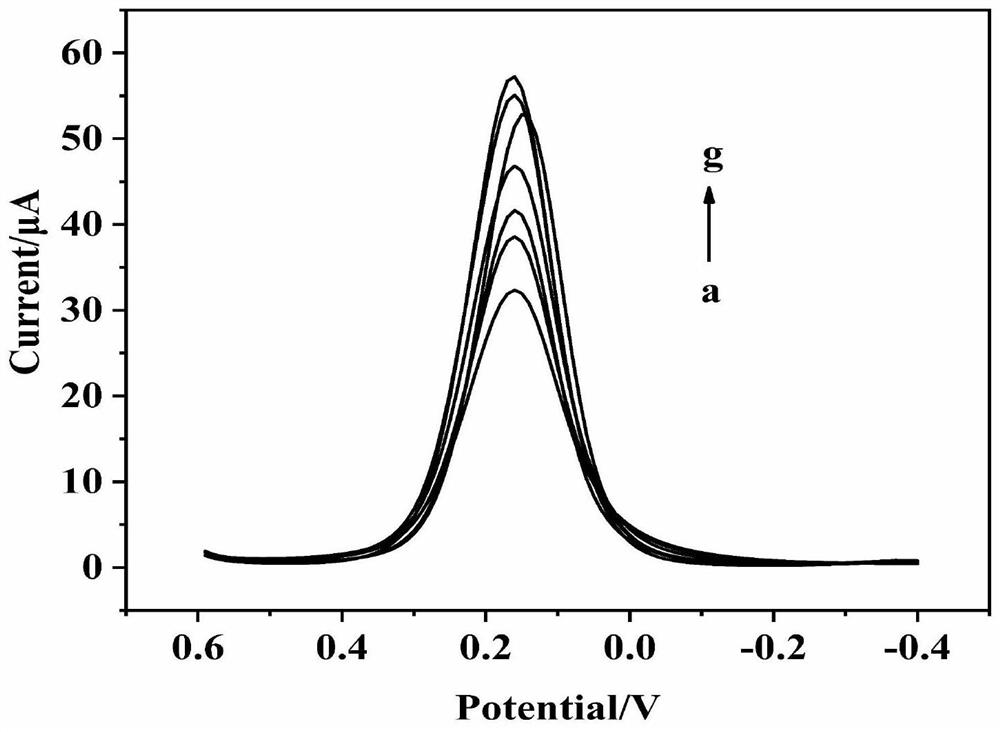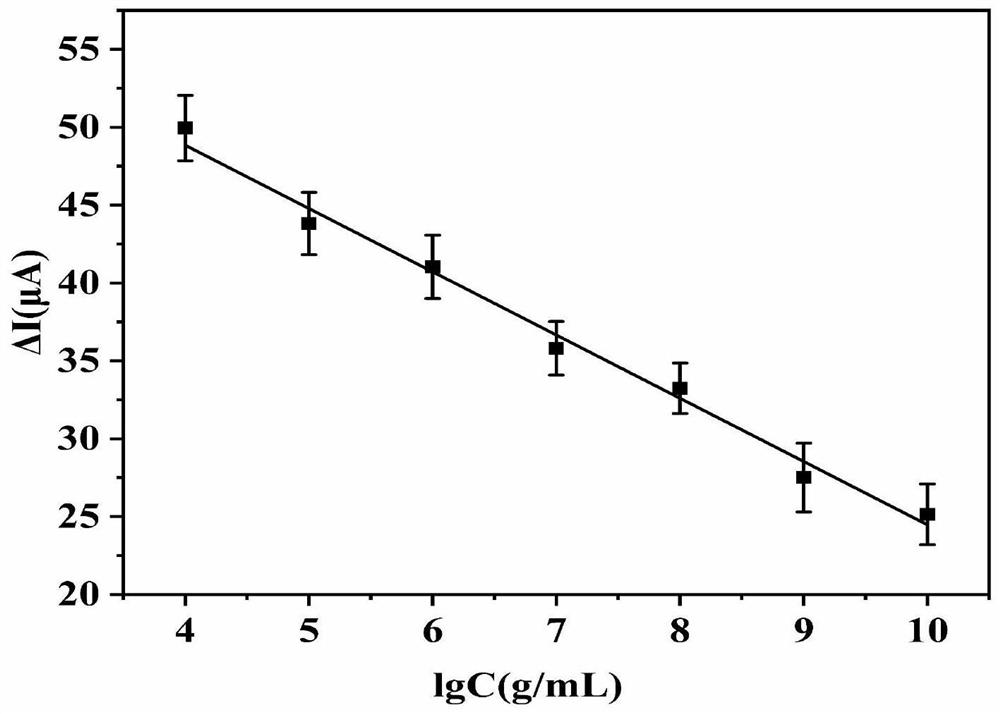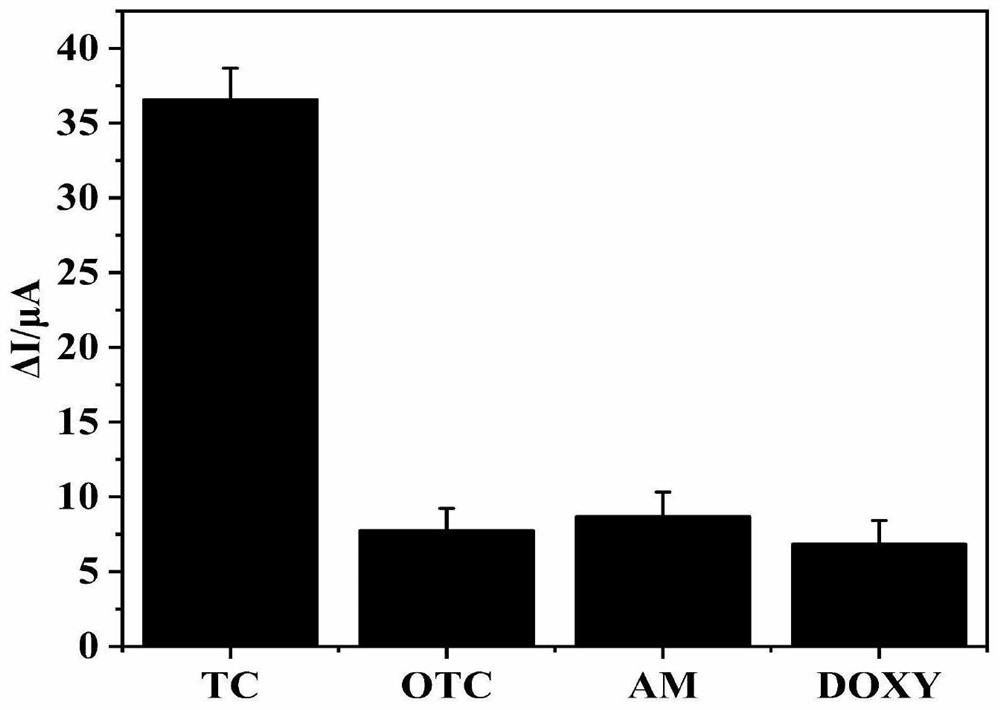Magnetic COF surface molecular imprinting electrochemical sensor as well as preparation method and application thereof
A surface molecular imprinting and electrochemistry technology, applied in the fields of material electrochemical variables, scientific instruments, material analysis by electromagnetic means, etc., can solve the problems of low detection sensitivity, incomplete reorganization, tight structure, etc., and achieve high specificity detection. Effect
- Summary
- Abstract
- Description
- Claims
- Application Information
AI Technical Summary
Problems solved by technology
Method used
Image
Examples
Embodiment 1
[0033] A method for preparing a magnetic COF surface molecularly imprinted material, comprising the steps of:
[0034] Step 1, adopt the synthetic method at room temperature, prepare Fe 3 o 4 @COF Composites: Fe 3 o 4 (0.15 g, 0.65 mmol) was suspended in 50 mL of dimethyl sulfoxide solution containing 1,3,5-triformylbenzene (0.3 mmol) and benzidine (0.45 mmol), and then sonicated for 10 min. Afterwards, acetic acid (2mL) was slowly added to the mixed solution, and reacted at room temperature for 20min to form a brown precipitate (Fe 3 o 4 @COF), the resulting brown precipitate was collected with a magnet and washed several times with THF and anhydrous methanol. Finally, the obtained brown precipitate was dried in a vacuum oven to obtain Fe 3 o 4 @COF Composites;
[0035] Step 2, preparation of molecularly imprinted materials on the magnetic COF surface: Take 0.1 mL of functional monomer 3-aminopropyltriethoxysiloxane (APTES) and 20 mg of template molecule tetracycline ...
Embodiment 2
[0037] A method for preparing a magnetic COF surface molecularly imprinted material, comprising the steps of:
[0038] Step 1, adopt the synthetic method at room temperature, prepare Fe 3 o 4 @COF Composites: Fe 3 o 4 (0.15 g, 0.65 mmol) was suspended in 50 mL of dimethyl sulfoxide solution containing 1,3,5-triformylbenzene (0.3 mmol) and benzidine (0.45 mmol), and then sonicated for 10 min. Afterwards, acetic acid (2mL) was slowly added to the mixed solution, and reacted at room temperature for 20min to form a brown precipitate (Fe 3 o 4 @COF), the resulting brown precipitate was collected with a magnet and washed several times with THF and anhydrous methanol. Finally, the obtained brown precipitate was dried in a vacuum oven to obtain Fe 3 o 4 @COF Composites;
[0039] Step 2, preparation of molecularly imprinted materials on the magnetic COF surface: Take 0.5 mL of the functional monomer 3-aminopropyltriethoxysiloxane (APTES) and 20 mg of the template molecule tetra...
Embodiment 3
[0041] A method for preparing a magnetic COF surface molecularly imprinted material, comprising the steps of:
[0042] Step 1, adopt the synthetic method at room temperature, prepare Fe 3 o 4 @COF Composites: Fe 3 o 4 (0.15 g, 0.65 mmol) was suspended in 50 mL of dimethyl sulfoxide solution containing 1,3,5-triformylbenzene (0.3 mmol) and benzidine (0.45 mmol), and then sonicated for 10 min. Afterwards, acetic acid (2mL) was slowly added to the mixed solution, and reacted at room temperature for 20min to form a brown precipitate (Fe 3 o 4 @COF), the resulting brown precipitate was collected with a magnet and washed several times with THF and anhydrous methanol. Finally, the obtained brown precipitate was dried in a vacuum oven to obtain Fe 3 o 4 @COF Composites;
[0043] Step 2, preparation of molecularly imprinted materials on the magnetic COF surface: Take 0.7 mL of the functional monomer 3-aminopropyltriethoxysiloxane (APTES) and 20 mg of the template molecule tetra...
PUM
 Login to View More
Login to View More Abstract
Description
Claims
Application Information
 Login to View More
Login to View More - R&D
- Intellectual Property
- Life Sciences
- Materials
- Tech Scout
- Unparalleled Data Quality
- Higher Quality Content
- 60% Fewer Hallucinations
Browse by: Latest US Patents, China's latest patents, Technical Efficacy Thesaurus, Application Domain, Technology Topic, Popular Technical Reports.
© 2025 PatSnap. All rights reserved.Legal|Privacy policy|Modern Slavery Act Transparency Statement|Sitemap|About US| Contact US: help@patsnap.com



